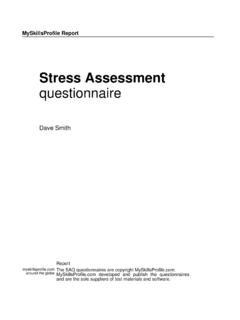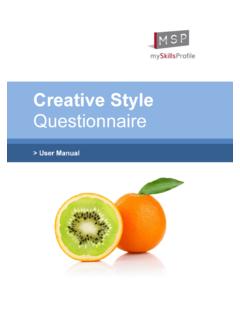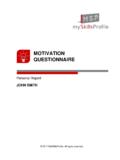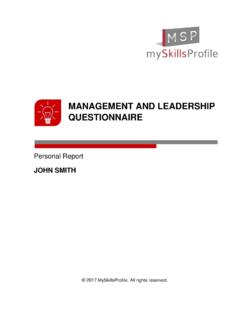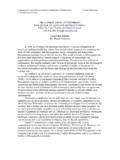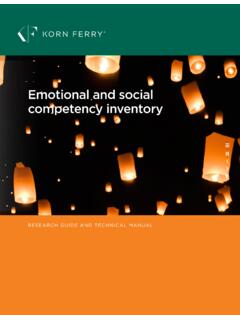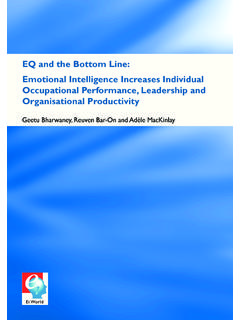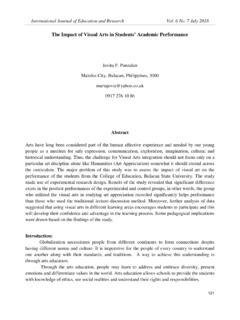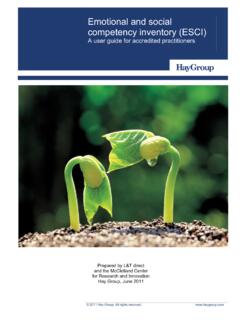Transcription of Emotional Intelligence Questionnaire ... - MySkillsProfile
1 Emotional Intelligence Questionnaire > User Manual Reviewed by BUROS CENTER FOR TESTING 2014, Limited. EIQ16 is a trademark of Limited. All rights reserved. No part of this publication may be reproduced or distributed in any form or by any means or stored in a database or retrieval system without the prior written permission of Limited. 3 EIQ16 User Manual Contents INTRODUCTION .. 5 EIQ16 Questionnaire .. 5 Concept Model .. 5 Versions .. 6 Access .. 6 Design Criteria .. 6 Development Overview .. 6 EI 7 EI Measures .. 8 EIQ16 Emotional Intelligence Test .. 11 ADMINISTRATION .. 16 Administered by Professional.
2 16 Direct Access .. 16 Scoring and Norming .. 16 SCALE DESCRIPTIONS .. 17 Scale Items .. 17 Relationships with Other Scales .. 17 Scale Contents .. 17 INTERPRETATION AND FEEDBACK REPORT .. 35 Sten Scores .. 35 Feedback Report .. 36 RELIABILITY AND VALIDITY .. 37 Internal Consistency Reliabilities .. 37 Correlations between Versions .. 38 Scale Intercorrelations .. 39 Intercorrelations and Reliability .. 39 4 EIQ16 User Manual Standard Error of Difference .. 39 Factor Analysis .. 43 Relationship to Other Measures .. 44 Correlations with Job Performance .. 45 Demographics and EIQ16 scales .. 49 Impression Management .. 53 NORMS .. 54 REFERENCES .. 61 5 EIQ16 User Manual Introduction This User Manual describes the administration, interpretation and technical properties of the EIQ16.
3 It is available as a soft copy download only from EIQ16 Questionnaire The EIQ16 Emotional Intelligence Questionnaire is designed to provide information about a person s Emotional Intelligence . The purpose of the instrument is to help people understand and develop Emotional qualities, competencies and skills to improve their performance and reach their potential. Concept Model The EIQ16 Questionnaire is based on the model of Emotional Intelligence developed by Mayer, Salovey and Caruso (2002). This model of Emotional Intelligence has four key branches which in the EIQ16 are named as follows: Reading People, Using Emotions, Understanding Emotions, and Managing Emotions. Figure 1. Mayer, Salovey and Caruso model of Emotional Intelligence Reading people, according to Mayer at al, covers the ability to recognize emotions in oneself and others as well as in objects, art, stories, music and other phenomena.
4 Using emotions is the ability to generate, use and feel emotion to communicate feelings and employ them in thinking and decision making. Understanding emotions means being able to appreciate Emotional information and to realize how emotions combine and progress through relationship transitions. Managing emotions describes the ability to be open to feelings and to control them in oneself and others in order to advance personal understanding and growth. Reading PeopleUsing EmotionsUnderstanding EmotionsManaging Emotions 6 EIQ16 User Manual The EIQ16 is a behavioral style instrument whereas the Mayer-Salovey-Caruso Emotional Intelligence Test is an ability-based test. Versions There are two versions of the Questionnaire . EIQ16 normative Questionnaire .
5 The full normative Questionnaire requires a test taker to rate their Emotional skills and competencies using a 5 point Likert scale ranging from Strongly agree to Strongly disagree . The test also has one scale measuring impression management. The Questionnaire consists of 136 statements (8 items per scale) and most test takers complete the questions in about 20 minutes. Table 1 summarizes what the EIQ16 Questionnaire scales measure. More detailed descriptions of scale content are provided in Chapter 3. EIQ16 app. The App version of the Questionnaire is a short instrument measuring the 4 key branches of Emotional Intelligence depicted in Figure 1. It also provides an indication of impression management. This short test has 36 items taken from the full Questionnaire and takes about 5 minutes to complete.
6 Access The EIQ16 is designed to be used by psychologists, coaches and other HR professionals but can also be purchased direct by individual managers and professionals from the website Design Criteria The EIQ16 was designed to meet the key criteria in the EFPA Review Model for the Description and Evaluation of Psychological Tests (Bartram, 2002). The EFPA Review Model was produced to support and encourage the process of harmonizing the reviewing of tests. It provides a standard set of criteria to assess the quality of modern psychometric tests. These cover the common areas of test review such as norms, reliability, and validity. Development Overview The development of the EIQ16 can be broken down into five phases. Phase 1. In the first phase of development we carried out a literature review and content analysis of models and measures of Emotional Intelligence and built a concept model based on the four-branch ability model of EI.
7 7 EIQ16 User Manual Phase 2. In the beta phase, we created an inventory with Emotional competency scales and an impression management scale in the style of a behavioral style assessment test. We piloted the inventory online, analyzed the reliability and validity, generated norms, and produced a technical manual. The assessment was initially made available as a free test for several months before the first commercial version was launched in 2006. Phase 3. In the third phase of development, we collected more data, conducted further analysis, and made incremental improvements to enhance the reliability of the scales and improve the format and contents of the computer-generated feedback report. We updated the user manual in the second half of 2011 in preparation for a test review.
8 We submitted the instrument to the British Psychological Society (BPS) for review in the first half of 2012 and the review was published in July 2012. Phase 4. In the fourth phase of development, we built a short 4 scale version of the Questionnaire which we published as a free app in 2013. The items for the app were selected by carrying out a 4-factor forced extraction and selecting the items that loaded highest on each factor. The free app can be downloaded from Google Play. Phase 5. In the fifth phase of development following the BPS review, we decided to look again at the factor structure of the instrument using a procedure researchers have utilized to remove response acquiescence. With response acquiescence removed, we found stronger evidence for a factor model more congruent with the original concept model.
9 We revised the user manual to reflect these findings and address other issues raised by the BPS review. The revised manual was published in October 2014 and submitted to the Buros Center for Testing for Review in 2015. The review is due to appear in The Twentieth Mental Measurements Yearbook in 2017. The rest of this chapter describes the development process and rationale for the design of the assessment in more detail. EI Models There are three distinct models/frameworks in the field of Emotional Intelligence (Cherniss, 2010): an ability model, a competency model, and a personality trait model. Ability model. Mayer and Salovey are the leading exponents of the ability model. In their 1990 article, Mayer and Salovey define EI as a subset of social Intelligence that involves the ability to monitor one s own and others feelings and emotions, to discriminate among them and to use this information to guide one s thinking and actions.
10 Further work and reviews of the literature led the authors to divide EI skills and abilities into four areas covering the ability to (a) perceive emotion, (b) use emotion to facilitate thought, (c) understand emotions, and (d) manage emotions. Mayer, Salovey, and Caruso (2004) state that EI is a member of a class of hot intelligences dealing with personal and Emotional cognitive processes. The Mayer-Salovey-Caruso Emotional Intelligence Test (MSCEIT) has eight scales with two measuring each of the four branches of EI. The Perceiving Emotions scales ask test takers to identify (a) emotions in faces, and (b) the emotions conveyed by landscapes and designs. The Using Emotions scales ask test takers to (a) compare emotions to other tactile and 8 EIQ16 User Manual sensory stimuli, and (b) identify the emotions that facilitate different types of thinking.

